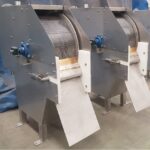The DET36 ROTARY DRUM SCREEN is a machine that is designed to filter or sieve liquids from a continuous process with a specific percentage of solids in suspension.
These units have a filtration mesh with particle filter capacity that can vary from 0.05 to 5 mm. This provides a solution to many sieving problems present in different sectors, such as the food, paper, textile and chemical industries and waste water treatment processes, etc.
The rotary drum screen works by the liquid entering the pipes connected to the flanged branch located in the upper part of the tank. It is distributed evenly across the drum that is the mesh filter, which the drive unit keeps in constant rotation. The solid particles are retained outside this cylinder and displaced towards the scraper which is continuously cleaning the drum. They are deposited in the discharge tray and sent to a container, transporter auger - compactor, belt, etc. The sieved effluent exits the rotating sieve/spin-sieve via the lower pipe in the tank.
The result of this arrangement is that the rotary drum screen are ideal units for effective continuous solid-liquid separation work and they require little maintenance (either mechanical or cleaning).
MAIN COMPONENTS OF THE DET36 ROTARY DRUM SCREEN
FILTRATION DRUM
This is the main component of the rotary drum screen as it is where the effluent is sieved. It is made from stainless steel with special cradle-shaped profiles which roll up to form a mechanically welded helical cylinder, producing a self-cleaning effect. The particles that are too large to go through the sieve are retained on the surface from where they are removed by an ejector scraper. It is built with variable pitch, depending on demand and the type of liquid to be sieved.
TANK – FRAME
enclosure made from laser-cut, folded and welded metal plate (normally stainless steel). It is home to the drum filter and it supports the drive unit. Its construction means two independent enclosures are formed: the upper contains the incoming liquid; the lower is where the sieved liquid gathers. Each enclosure has its own flanged inlet and outlet branches; their location may be chosen according to installation needs.
DRIVE
this is the drive unit comprising a hollow shaft geared motor installed on the side of the rotary drum screen which operates the drum filter. Depending on requirements, it may be equipped with one or two-speed rotation, thus increasing filtration capacity. They are built to work continuously.
SCRAPER
this constitutes the waste removal system for the rotary drum screen. An ejector scraper works constantly, brushing against the drum filter to loosen the waste stuck to the mesh, which is then collected in the out-tray and deposited in a suitable container.
REAR SCRAPER
located inside the rotary drum screen tank and brushing against the cylinder filter, it has a dual purpose: cleaning the rear of the drum and preventing non-sieved flow from passing.
CLEANING UNIT
comprising nozzles located inside the rotating sieve/spin-sieve drum which clean the mesh with pressurised water, pushing the stuck-on waste towards the exterior, ejecting it along with the sieved water









